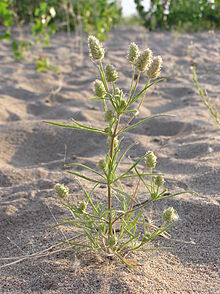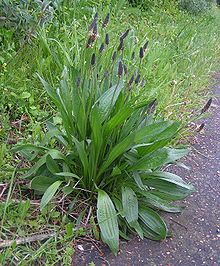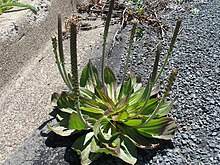Plantains
| Plantains | ||||||||||||
|---|---|---|---|---|---|---|---|---|---|---|---|---|

Plantain ( Plantago major ) |
||||||||||||
| Systematics | ||||||||||||
|
||||||||||||
| Scientific name | ||||||||||||
| Plantago | ||||||||||||
| L. |
The plantains ( Plantago ) are a genus of flowering plants in the family of Plantain Family (Plantaginaceae).
description

Appearance and leaves
The plantain species grow as annual to perennial herbaceous plants or dwarf shrubs . The leaves are arranged in a basic rosette or opposite or alternating on the stem. The leaves are so-called "Rhachis leaves": The leaf blade consists only of the Rhachis , which is why the leaf veins are parallel or arched.
Inflorescences, flowers and fruits
On more or less long stalk-round or furrowed inflorescence shafts there are many-flowered, head-shaped or spike-like inflorescences . The flowers are four-fold. The corolla lobes usually stick out or are bent back. The stamens start in the corolla tube. The ovary is two- to four-chambered. The capsule fruits contain several seeds.







Systematics
The genus Plantago was established in 1753 by Carl von Linné . Synonyms for Plantago L. are: Psyllium Mill. , Littorella P.J.Bergius .
The genus Plantago belongs to the tribe Plantagineae within the Plantaginaceae . It used to be part of the Veronicaceae family.
The genus Plantago is divided into several sub-genera, some of which are further divided into sections:
- Subgenus Bougueria (Decne.) Rahn
- Subgenus Coronopus (Lam. & DC.) Rahn :
- Coronopus DC section .
- Section Maritimae H. Dietr.
- Subgenus Littorella (PJBergius) Rahn
- Subgenus Plantago
- Subgenus Psyllium :
- Section of Albicantes
- Section Gnaphaloides
- Hymenopsyllium section
- Section Lanceifoliae
- Section Montanae
- Section psyllium
species
About 190 species are distinguished in the genus Plantago . Here is a selection of species:
- Psyllium plantain ( Plantago afra L. , Syn .: Plantago psyllium auct.) (Subg. Psyllium sect. Psyllium ): It is widespread in southern Europe , the Canary Islands , Africa , West and Central Asia to Pakistan .
- Whitish plantain ( Plantago albicans L. ) (subg. Psyllium sect. Albicantes ): It is widespread from southern Europe through North Africa and the Canary Islands and western Asia .
- Alpine plantain ( Plantago alpina L. ): The range extends from Spain through the Alps to the Balkan Peninsula.
- Plantain ( Plantago amplexicaulis Cav. ) (Subg. Psyllium sect. Albicantes ): It is widespread from southern Europe through North Africa and the Canary Islands to West Asia and from India to Pakistan.
- Plantago arborescens Poir. : Endemic dwarf shrub of the Canary Islands
- Sand plantain ( Plantago arenaria Waldst. & Kit. , Syn .: Plantago indica L. , Plantago psyllium L. , Plantago scabra Moench ) (subg. Psyllium sect. Psyllium ): It is widespread from Europe to North Africa and from West Asia to Siberia .
- Plantago argyrea E. Morris (subg. Psyllium sect. Gnaphaloides ): The home is the southern USA and Mexico .
- Plantago aristata Michx. (subg. Psyllium sect. Gnaphaloides ): The home is the USA; she is a neophyte in Ukraine and China.
- Plantago asiatica L. (subg. Plantago ): The home is India, Indochina , Malaysia , China , Japan , Korea and Taiwan.
- Mountain plantain ( Plantago atrata Hoppe ) (subg. Psyllium sect. Montanae ): The home is Europe and West Asia.
- Plantago australis Lam. (subg. Plantago ): The at least eight subspecies are widespread from North to Central and South America.
- Plantago cordata Lam. (subg. Plantago ): It is widespread from Canada to the USA.
- Crow's foot plantain ( Plantago coronopus L. ) (subg. Coronopus sect. Coronopus ): Home is Europe, North Africa, Macaronesia and Asia; it is a neophyte in Australia, New Zealand and North America.
- Plantago debilis R.Br. (subg. Bougueria ): The home is Australia.
- Plantago depressa Willd. (subg. Plantago ), (Syn .: Plantago tibetica Hook. f. & Thomson ): The homeland is Asia.
- Plantago elongata Pursh (subg. Plantago ): It is widespread from Canada via the USA to Mexico.
- Plantago erecta E. Morris (subg. Psyllium sect. Gnaphaloides ): The home is the USA and Mexico.
- Plantago hawaiensis (A. Gray) Pilg. (subg. Plantago ): The home is Hawaii.
- Plantago helleri Small (subg. Psyllium sect. Gnaphaloides ): The home is New Mexico and Texas.
- Kiel plantain ( Plantago holosteum Scop. ) (Subg. Coronopus sect. Coronopus ): The home is southern Europe and western Asia.
- Plantago hookeriana fish. & CAMey. (subg. Psyllium sect. Gnaphaloides ): The home is Texas and Mexico.
- Hares foot plantain ( Plantago lagopus L. ) (subg. Psyllium sect. Lanceifoliae ): The home is southern Europe, North Africa, Macaronesia and western Asia.
- Plantain ( Plantago lanceolata L. ) (. Subg psyllium sect. Lanceifoliae ): The home is Europe, North Africa and Asia; naturalized the species occurs worldwide.
- Plantago macrocarpa Cham. & Schltdl. (subg. Plantago ): The home is British Columbia, Oregon, Washington, Alaska and the Kamchatka.
- Plantain ( Plantago major L. ) (subg. Plantago ): Home is Eurasia, but the species is naturalized worldwide.
- Beach plantain ( Plantago maritima L. ) (subg. Coronopus sect. Maritimae ): The home is Europe, Asia, North Africa and America.
- Middle plantain ( Plantago media L. ) (subg. Plantago ): The home is Europe and Asia.
- Plantago orzuiensis Mohsenz., Nazeri & Mirtadz. (subg. Psyllium sect. Albicantes ): The homeland is Iran.
- Indian Psyllium ( Plantago ovata . Forssk ) (. Subg psyllium sect. Albicantes ): Synonyms are Plantago fastigiata E.Morris , Plantago insularis Eastw. and Plantago ispaghula Roxb. ex Fleming . The home is Spain, North Africa, the Canaries, Madeira, West Asia to Pakistan; the species also occurs as a neophyte in North America.
- Plantago patagonica Jacq. (subg. Psyllium sect. Gnaphaloides ): Synonyms are Plantago lagopus Pursh and Plantago purshii Roem. & Schult. : The home is Canada, the USA, Mexico, Argentina and Chile.
- Plantago princeps Cham. & Schltdl. (subg. Plantago ): The home is Hawaii.
- Plantago pusilla Nutt. (subg. Plantago ): The home is the USA.
- Plantago rhodosperma Decne. (subg. Plantago ): The home is the USA and Mexico.
- Plantago rugelii Decne. (subg. Plantago ): The home is Canada and the USA.
- Shrub plantain ( Plantago sempervirens Crantz , Syn .: Plantago cynops sensu L. ) (subg. Psyllium sect. Psyllium ): Home is Portugal, Spain, France, Italy and Turkey.
- Saw-blade plantain ( Plantago serraria L. ) (subg. Coronopus sect. Coronopus ): The home is Morocco, Algeria, Tunisia, Portugal, Spain, Italy, Malta, Greece and the former Yugoslavia.
- Plantago subnuda Pilg. : The home is Oregon and California.
- Awl-leaved plantain ( Plantago subulata L. )
- Strandling ( Plantago uniflora L. ) ( subg.Littorella ): A synonym is Littorella uniflora (L.) Asch. : The home is Europe and the Azores.
- Plantago virginica L. (subg. Plantago ): The home is Mexico and the USA; The species is naturalized in China, Japan, the Caribbean and Canada.
- Plantago wrightiana Decne. (subg. Psyllium ): The home is the USA and Mexico.
Etymology and history of use
The term "plantain" (probably formed in analogy to personal names such as Friedrich or Dietrich) is probably not to be interpreted as a "path ruler", but rather indicates the location on paths . The name Plantago is derived from the Latin "Planta" for sole of the foot.
Already in antiquity, but also in Shakespeare's 'Romeo and Juliet', the leaves of the plantain (here especially Plantago maior L. or Plantago lanceolata L. ) were placed on wounds and inflamed areas. The plantain root was also used less often (e.g. for menstrual cramps). The ancient doctors Galenus and Dioscurides list numerous areas of application for the plantain in their writings, v. a. it should be used for all malignant ulcers, rivers, putrefactive processes, dysentery, bleeding. According to Dioscurides , the plantain also helps epileptics and asthmatics.
swell
literature
- Siegmund Seybold (Ed.): Schmeil-Fitschen interactive . CD-ROM, version 1.1. Quelle & Meyer, Wiebelsheim 2002, ISBN 3-494-01327-6 .
- Ehrentraud Bayer, Karl Peter Buttler, Xaver Finkenzeller, Jürke Grau: Plants of the Mediterranean (= Steinbach's natural guide . Volume 17 ). Mosaik, Munich 1987, ISBN 3-570-01347-2 .
- Ingrid Schönfelder, Peter Schönfelder : Kosmos-Atlas Mediterranean and Canary Islands flora. Over 1600 species of plants . Franckh-Kosmos, Stuttgart 1994, ISBN 3-440-06223-6 .
Individual evidence
- ↑ a b Karol Marhold, 2011: Plantaginaceae : Datasheet Plantago In: Euro + Med Plantbase - the information resource for Euro-Mediterranean plant diversity.
- ↑ a b c d e f g h i j k l m n o p q r s t u v w x y z aa ab ac ad ae af ag ah ai aj ak al am an Plantago in the Germplasm Resources Information Network (GRIN) , USDA , ARS , National Genetic Resources Program. National Germplasm Resources Laboratory, Beltsville, Maryland.
- ^ Jörg Mildenberger: Anton Trutmann's 'Pharmacopoeia', Part II: Dictionary. Volume 5, W-Z. Attachments. In: Würzburg medical historical research. Volume 56, No. 5, 1997, pp. 2260f.
- ↑ Eckart Mießner: Flowers in the woods and fields. Urania-Verlag, Leipzig a. a. 1966.
- ↑ Vagn Jørgensen Brøndegaard: plantain as a wound healing agent in folk and traditional medicine. In: Sudhoff's archive. Volume 47, 1963, pp. 127-151; also in: Folk Medicine: Problems and Research History. Edited by Elfriede Grabner. Darmstadt 1967 (= ways of research. Volume 63), pp. 509-537.
further reading
- Knud Rahn: A phylogenetic study of the Plantaginaceae. In: Botanical Journal of the Linnean Society. Volume 120, No. 2, 1996, pp. 145-198, DOI: 10.1111 / j.1095-8339.1996.tb00484.x .
- Nina Rønsted, Mark W. Chase, Dirk C. Albach, Maria Angelica Bello: Phylogenetic relationships within Plantago (Plantaginaceae): evidence from nuclear ribosomal ITS and plastid TrnL-F sequence data. In: Botanical Journal of the Linnean Society. Volume 139, No. 4, 2002, pp. 323-338, DOI: 10.1046 / j.1095-8339.2002.00070.x .

